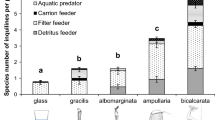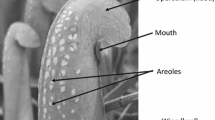Abstract
Mechanisms that improve prey richness in carnivorous plants may involve three crucial phases of trapping: attraction, capture and retention. Nepenthes rafflesiana var. typica is an insectivorous pitcher plant that is widespread in northern Borneo. It exhibits ontogenetic pitcher dimorphism with the upper pitchers trapping more flying prey than the lower pitchers. While this difference in prey composition has been ascribed to differences in attraction, the contribution of capture and retention has been overlooked. This study focused on distinguishing between the prey trapping mechanisms, and assessing their relative contribution to prey diversity. Arthropod richness and diversity of both visitors and prey in the two types of pitchers were analysed to quantify the relative contribution of attraction to prey trapping. Rate of insect visits to the different pitcher parts and the presence or absence of a sweet fragrance was recorded to clarify the origin and mechanism of attraction. The mechanism of retention was studied by insect bioassays and measurements of fluid viscosity. Nepenthes rafflesiana was found to trap a broader prey spectrum than that previously described for any Nepenthes species, with the upper pitchers attracting and trapping a greater quantity and diversity of prey items than the lower pitchers. Capture efficiency was low compared with attraction or retention efficiency. Fragrance of the peristome, or nectar rim, accounted mainly for the observed non-specific, better prey attraction by the upper pitchers, while the retentive properties of the viscous fluid in these upper pitchers arguably explains the species richness of their flying prey. The pitchers of N. rafflesiana are therefore more than simple pitfall traps and the digestive fluid plays an important yet unsuspected role in the ecological success of the species.
Similar content being viewed by others
References
Adam J H 1997 Prey spectra of Bornean Nepenthes species (Nepenthaceae) in relation to their habitat; Pertanika J. Trop. Agric. Sci. 20 121–134
Beaver R A 1983 The communities living in Nepenthes pitcher plants: fauna and food webs; in Phytotelmata: terrestrial plants as hosts for aquatic insect communities (eds) J H Frank and L P Lounibos (Medford, New Jersey, USA: Plexus Publishing, Inc.) pp 129–160
Blüthgen N and Fledler K 2004 Competition for composition: lessons from nectar-feeding ant communities: Community and evolutionary ecology of nectar; Ecology 85 1479–1485
Bohn H F and Fiederle W 2004 Insect aquaplaning: Nepenthes pitcher plants capture prey with the peristome, a fully wettable water-lubricated anisotropic surface; Proc. Natl. Acad. Sci. USA 101 14138–14143
Brühl C A, Gunsalam G and Linsenmair K E 1998 Stratification of ants (Hymenoptera, Formicidae) in a primary rain forest in Sabah, Borneo; J. Trop. Ecol. 14 285–297
Cheek M and Jebb M 2001 Nepenthaceae; in Flora Malaysiana,, S1, Seed Plants (Leiden, the Netherlands: Publication Department of the National Herbarium Nederland) p. 164
Clarke C 1997 Nepenthes of Borneo (Kota Kinabalu, Sabah, Malaysia: Natural History Publications [Borneo])
Clarke C 2001 Nepenthes of Sumatra and Peninsular Malaysia (Kota Kinabalu, Sabah, Malaysia: Natural History Publications [Borneo])
Davidson D W, Cook S C, Snelling R R and Chua T H 2003 Explaining the abundance of ants in lowland tropical rainforest canopies; Science 300 969–972
Di Giusto B, Anstett M-C, Dounias E and McKey D B 2001 Variation in the effectiveness of biotic defense: the case of an opportunistic ant-plant protection mutualism; Oecologia 129 367–375
Di Giusto B, Guéroult M, Rowe N and Gaume L 2008 The waxy surface in Nepenthes pitcher plants: variability, adaptive significance and developmental evolution; in Functional surfaces in biology (ed) S. Gorb (Berlin: Springer) (in press)
Ellison A M, Gotelli N J, Brewer J S, Cochran-Stafira D L, Kneitel J M, Miller T E, Worley A C and Zamora R 2003 The evolutionary ecology of carnivorous plants; Adv. Ecol. Res. 33 1–74
Gaume L, Gorb S and Rowe N 2002 Function of epidermal surfaces in the trapping efficiency of Nepenthes alata pitchers; New Phytol. 156 479–489
Gaume L, Perret P, Gorb E, Gorb S, Labat J-J and Rowe N 2004 How do plant waxes cause flies to slide? Experimental tests of wax-based trapping mechanisms in three pitfall carnivorous plants; Arthropod Struct. Dev. 33 103–111
Gaume L, Zacharias M, Grosbois V and Borges R M 2005 The fitness consequences of bearing domatia and having the right ant partner: experiments with protective and non-protective ants in a semi-myrmecophyte; Oecologia 145 76–86
Glossner F 1992 Ultraviolet patterns in the traps and flowers of some carnivorous plants; Bot. Jahrb. Syst. 113 577–587
Gorb E, Haas K, Henrich A, Enders S, Barbakadze N and Gorb S 2005 Composite structure of the crystalline epicuticular wax layer of the slippery zone in the pitchers of the carnivorous plant Nepenthes alata and its effect on insect attachment; J. Exp. Biol. 208 4651–4662
Jaffe K, Blum M S, Fales H M, Mason R T and Cabrera A 1995 On insect attractants from pitcher plants of the genus Heliamphora (Sarraceniaceae); J. Chem. Ecol. 21 379–384
Joel D M 1988 Mimicry and mutualism in carnivorous pitcher plants (Sarraceniaceae, Nepenthaceae, Cephalotaceae, Bromeliaceae); Biol. J. Linn. Soc. 35 185–197
Joel D M, Juniper B E and Dafni A 1985 Ultraviolet patterns in the traps of carnivorous plants; New Phytologist 101 585–593
Juniper B E and Burras J 1962 How pitcher plants trap insects; New Sci. 13 75–77
Juniper B E, Robins R J and Joel D 1989 The carnivorous plants (London, UK: Academic Press)
Kato M, Hotta M, Tamin R and Itino T 1993 Inter-and intra-specific variation in prey assemblages and inhabitant communities in Nepenthes pitchers in Sumatra; Trop. Zool. 6 11–25
Lloyd F E 1942 The carnivorous plants (Waltham, Mass., US: Chronica Botanica Co.)
Lüttge U 1983 Ecophysiology of carnivorous plants; in Encyclopedia of plant physiology (eds) O L Lange, P S Nobel, C B Osmond and H Ziegler (Berlin: Springer) pp 489–517
Massey B S 2006 Mechanics of fluids 8th edition, revised by J A Ward-Smith (ed) (London, New York: Taylor and Francis Routledge)
McKey D B, Gaume L, Brouat C, Di Giusto B, Pascal L, Debout G, Dalecky A and Heil M 2005 The trophic structure of tropical ant-plant-herbivore interactions: community consequences and coevolutionary dynamics; in Biotic interactions in the tropics (eds) D Burslem, M Pinard and S Hartley (Cambridge: Cambridge University Press) pp 386–413
Merbach M A, Zizka G, Fiala B, Maschwitz U and Booth W A 2001 Patterns of nectar secretion in five Nepenthes species from Brunei Darussalam, Northwest Borneo, and implications for ant-plant relationships; Flora 196 153–160
Miles D H, Kokpol U and Mody N V 1975 Volatiles in Sarracenia flava; Phytochemistry 14 845–846
Moran J A 1996 Pitcher dimorphism, prey composition and the mechanism of prey attraction in the pitcher plant Nepenthes rafflesiana in Borneo; J. Ecol. 84 515–525
Moran J A, Booth W E and Charles J K 1999 Aspects of pitcher morphology and spectral characteristics of six Bornean Nepenthes pitcher plant species: implications for prey capture; Ann. Bot. 83 521–528
Moran J A, Merbach M A, Livingston N J, Clarke C M and Booth W E 2001 Termite prey specialization in the pitcher plant Nepenthes albomarginata — evidence from stable isotope analysis; Ann. Bot. 88 307–311
Osunkoya O O, Daud S D, Di Giusto B, Wimmer F L and Holige T M 2007 Construction costs and physio-chemical properties of the assimilatory organs of Nepenthes species in northern Borneo; Ann. Bot. 99 895–906
Newell S J and Nastase A J 1998 Efficiency of insect capture by Sarracenia purpurea (Sarraceniaceae), the northern pitcher plant; Am. J. Bot. 85 88–91
Phillipps A and Lamb A 1996 Pitcher plants of Borneo (Kota Kinabalu, Sabah, Malaysia: Natural History Publications [Borneo])
Salmon B 1993 Some observations on the trapping mechanisms of Nepenthes inermis and N. rhombicaulis; Carnivorous Plant Newsletter 23 101–114
Schultze W, Schultze E D, Pate J S and Gillison A N 1997 The nitrogen supply from soils and insects during growth of the pitcher plants Nepenthes mirabilis, Cephalotus follicularis and Darlingtonia californica; Oecologia 112 464–471
Stork N E 2003 Biodiversity; in Encyclopedia of insects (eds) V H Resh and R T Cardé (Academic Press: San Diego, USA)
Author information
Authors and Affiliations
Corresponding author
Rights and permissions
About this article
Cite this article
Di Giusto, B., Grosbois, V., Fargeas, E. et al. Contribution of pitcher fragrance and fluid viscosity to high prey diversity in a Nepenthes carnivorous plant from borneo. J Biosci 33, 121–136 (2008). https://doi.org/10.1007/s12038-008-0028-5
Received:
Accepted:
Published:
Issue Date:
DOI: https://doi.org/10.1007/s12038-008-0028-5




